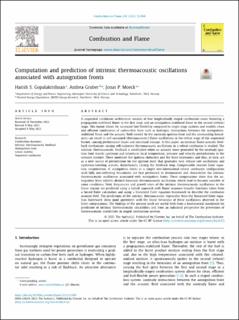| dc.contributor.author | Gopalakrishnan, Harish Subramanian | |
| dc.contributor.author | Gruber, Andrea | |
| dc.contributor.author | Moeck, Jonas | |
| dc.date.accessioned | 2024-01-16T09:45:23Z | |
| dc.date.available | 2024-01-16T09:45:23Z | |
| dc.date.created | 2023-06-06T14:36:49Z | |
| dc.date.issued | 2023 | |
| dc.identifier.issn | 0010-2180 | |
| dc.identifier.uri | https://hdl.handle.net/11250/3111716 | |
| dc.description.abstract | A sequential combustor architecture consists of two longitudinally staged combustion zones featuring a propagation-stabilized flame in the first stage and an autoignition-stabilized flame in the second (reheat) stage. This layout allows for increased fuel flexibility compared to single-stage systems and enables clean and efficient combustion of carbon-free fuels such as hydrogen. Interactions between the autoignition-stabilized flame and the acoustic field created by the unsteady ignition front and the surrounding boundaries can result in self-sustained (thermoacoustic) flame oscillations in the reheat stage of the sequential burner, causing performance losses and structural damage. In this paper, an intrinsic flame-acoustic feedback mechanism causing self-sustained thermoacoustic oscillations in a reheat combustor is studied. The intrinsic thermoacoustic feedback is established when an acoustic wave generated by the unsteady ignition front travels upstream and introduces local temperature, pressure and velocity perturbations in the unburnt mixture. These modulate the ignition chemistry and the front kinematics and thus, in turn, act as a new source of perturbation for the ignition front that generates heat release rate oscillations and upstream-traveling acoustic disturbances, closing the feedback loop. Compressible reactive Euler equation computations of autoignition fronts in a simple one-dimensional reheat combustor configuration with fully non-reflecting boundaries are first performed to demonstrate and characterize the intrinsic thermoacoustic oscillations associated with autoignition fronts. These computations show that the autoignition front exhibits distinct harmonic thermoacoustic oscillations which tend to become unstable at some conditions. Next, frequencies and growth rates of the intrinsic thermoacoustic oscillations in the linear regime are predicted using a hybrid approach with flame response transfer functions taken from a forced Euler calculation and using a linearized Euler equation framework to describe the combustor acoustic field. The predictions of the intrinsic thermoacoustic eigenvalue from the linearized Euler equation framework show good agreement with the linear behaviour of these oscillations observed in the Euler computations. The findings of the present work are useful both from a fundamental standpoint for prediction of intrinsic thermoacoustic instabilities and from an industrial perspective for prevention of thermoacoustic instabilities in staged combustion systems. © 2023 The Author(s) | en_US |
| dc.description.abstract | Computation and prediction of intrinsic thermoacoustic oscillations associated with autoignition fronts | en_US |
| dc.language.iso | eng | en_US |
| dc.publisher | Elsevier | en_US |
| dc.rights | Navngivelse 4.0 Internasjonal | * |
| dc.rights.uri | http://creativecommons.org/licenses/by/4.0/deed.no | * |
| dc.title | Computation and prediction of intrinsic thermoacoustic oscillations associated with autoignition fronts | en_US |
| dc.title.alternative | Computation and prediction of intrinsic thermoacoustic oscillations associated with autoignition fronts | en_US |
| dc.type | Peer reviewed | en_US |
| dc.type | Journal article | en_US |
| dc.description.version | publishedVersion | en_US |
| dc.source.volume | 254 | en_US |
| dc.source.journal | Combustion and Flame | en_US |
| dc.identifier.doi | 10.1016/j.combustflame.2023.112844 | |
| dc.identifier.cristin | 2152328 | |
| dc.relation.project | Norges forskningsråd: 295203 | en_US |
| cristin.ispublished | true | |
| cristin.fulltext | original | |
| cristin.qualitycode | 2 | |

